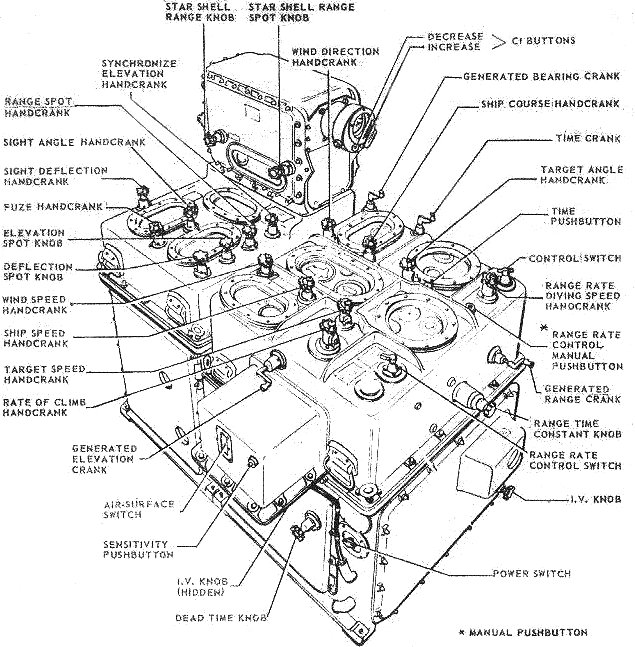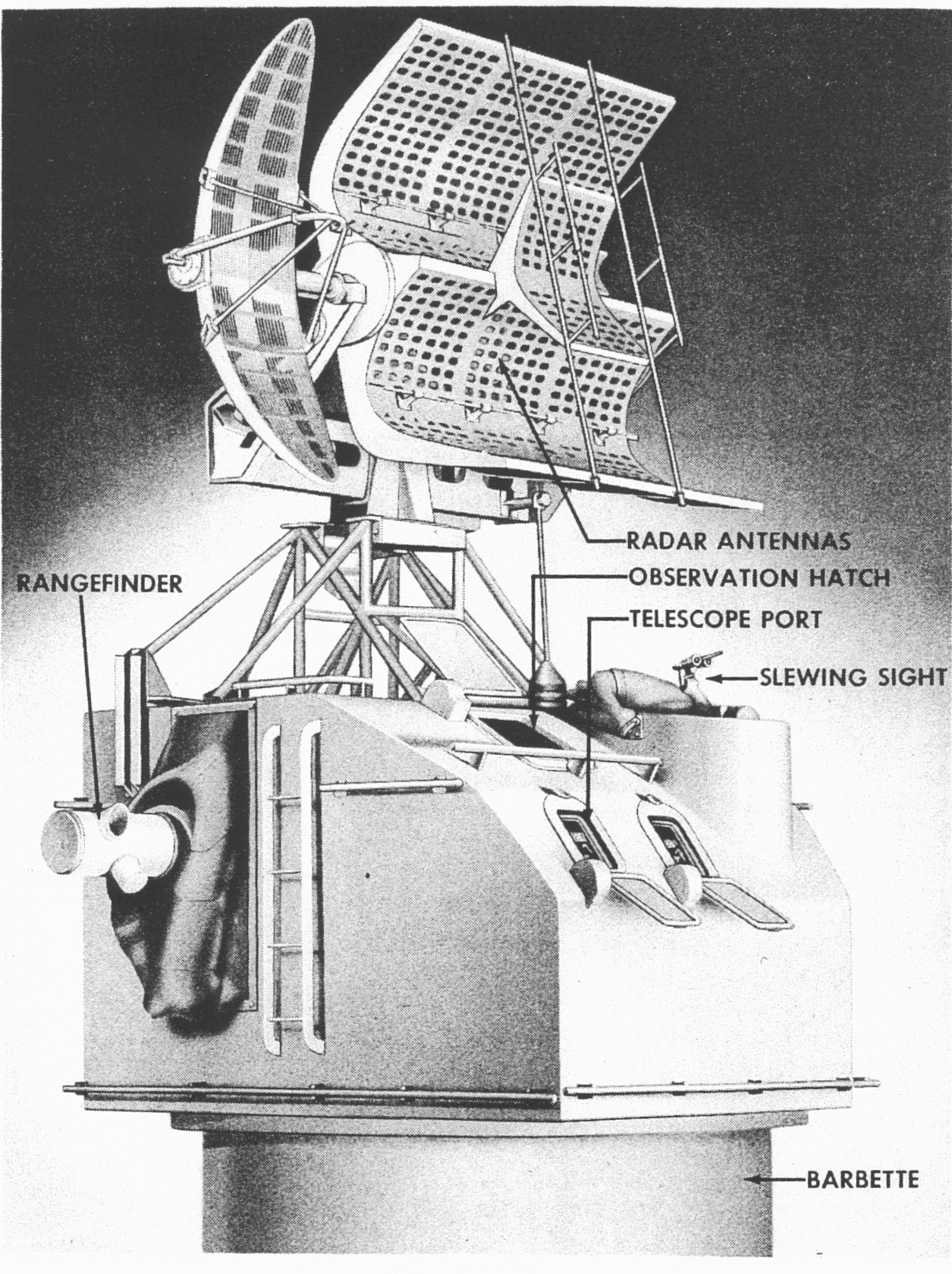|
Mark 8 Fire Control Computer
The Mark 8 Fire Control Computer was developed by Bell Laboratories during World War II. It was initially requested by the USN Bureau of Ordnance as an alternative to the Ford Instruments Mark I Fire Control Computer, in case supplies of the Mk I were interrupted or were unable to be manufactured in the required numbers. The Mk 8 computer used all electric methods of computation, in contrast to the Mk 1, which performed most computations via mechanical devices. The Mk 8 was found to be more accurate than the Mk 1 and substantially faster in reaching a fire control solution, but by the time it was developed and tested in 1944, supplies of the Mk 1 were found to be sufficient in quantity. The USN extensively tested the Mk 8 and may have incorporated some of its technology into the post war Ford Instruments Mk1A computer. The Mk 8 technology was similar to that used in the M9 gun data computer used by the US Army for coast defence fire control and in the SCR-584 radar The SCR-5 ... [...More Info...] [...Related Items...] OR: [Wikipedia] [Google] [Baidu] |
Bell Laboratories
Nokia Bell Labs, originally named Bell Telephone Laboratories (1925–1984), then AT&T Bell Laboratories (1984–1996) and Bell Labs Innovations (1996–2007), is an American industrial research and scientific development company owned by multinational company Nokia. With headquarters located in Murray Hill, New Jersey, the company operates several laboratories in the United States and around the world. Researchers working at Bell Laboratories are credited with the development of radio astronomy, the transistor, the laser, the photovoltaic cell, the charge-coupled device (CCD), information theory, the Unix operating system, and the programming languages B, C, C++, S, SNOBOL, AWK, AMPL, and others. Nine Nobel Prizes have been awarded for work completed at Bell Laboratories. Bell Labs had its origin in the complex corporate organization of the Bell System telephone conglomerate. In the late 19th century, the laboratory began as the Western Electric Engineering Department, l ... [...More Info...] [...Related Items...] OR: [Wikipedia] [Google] [Baidu] |
World War II
World War II or the Second World War, often abbreviated as WWII or WW2, was a world war that lasted from 1939 to 1945. It involved the vast majority of the world's countries—including all of the great powers—forming two opposing military alliances: the Allies and the Axis powers. World War II was a total war that directly involved more than 100 million personnel from more than 30 countries. The major participants in the war threw their entire economic, industrial, and scientific capabilities behind the war effort, blurring the distinction between civilian and military resources. Aircraft played a major role in the conflict, enabling the strategic bombing of population centres and deploying the only two nuclear weapons ever used in war. World War II was by far the deadliest conflict in human history; it resulted in 70 to 85 million fatalities, mostly among civilians. Tens of millions died due to genocides (including the Holocaust), starvation, ma ... [...More Info...] [...Related Items...] OR: [Wikipedia] [Google] [Baidu] |
Bureau Of Ordnance
The Bureau of Ordnance (BuOrd) was a United States Navy organization, which was responsible for the procurement, storage, and deployment of all naval weapons, between the years 1862 and 1959. History Congress established the Bureau in the Department of the Navy by an act of July 5, 1862 (12 Stat. 510), which transferred the hydrographic functions of the Navy's Bureau of Ordnance and Hydrography (1842–1862) to the newly established Bureau of Navigation. During the early 20th century, BuOrd became involved in the development of aerial weapons. This often led to friction with the Bureau of Aeronautics (BuAer), which had responsibility for the development of Naval aircraft. BuAer's work on "pilotless aircraft," or drones, conflicted with BuOrd's development of guided missiles. After World War II, the Navy examined ways to improve coordination between the two bureaus; ultimately, the decision was made to merge the two organizations into a new bureau, to be known as the Bureau of ... [...More Info...] [...Related Items...] OR: [Wikipedia] [Google] [Baidu] |
Mark I Fire Control Computer
The Mark 1, and later the Mark 1A, Fire Control Computer was a component of the Mark 37 Gun Fire Control System deployed by the United States Navy during World War II and up to 1991 and possibly later. It was originally developed by Hannibal C. Ford of the Ford Instrument Company. and William Newell. It was used on a variety of ships, ranging from destroyers (one per ship) to battleships (four per ship). The Mark 37 system used tachymetric target motion prediction to compute a fire control solution. It contained a target simulator which was updated by further target tracking until it matched. Weighing more than , the Mark 1 itself was installed in the plotting room, a watertight compartment that was located deep inside the ship's hull to provide as much protection against battle damage as possible. Essentially an electromechanical analog computer, the Mark 1 was electrically linked to the gun mounts and the Mark 37 gun director, the latter mounted as high on the superstructu ... [...More Info...] [...Related Items...] OR: [Wikipedia] [Google] [Baidu] |
Gun Fire Control Systems
Ship gun fire-control systems (GFCS) are analogue fire-control systems that were used aboard naval warships prior to modern electronic computerized systems, to control targeting of guns against surface ships, aircraft, and shore targets, with either optical or radar sighting. Most US ships that are destroyers or larger (but not destroyer escorts except Brooke class DEG's later designated FFG's or escort carriers) employed gun fire-control systems for and larger guns, up to battleships, such as . Beginning with ships built in the 1960s, warship guns were largely operated by computerized systems, i.e. systems that were controlled by electronic computers, which were integrated with the ship's missile fire-control systems and other ship sensors. As technology advanced, many of these functions were eventually handled fully by central electronic computers. The major components of a gun fire-control system are a human-controlled Director (military), director, along with or later rep ... [...More Info...] [...Related Items...] OR: [Wikipedia] [Google] [Baidu] |
Gun Data Computer
The gun data computer was a series of artillery computers used by the U.S. Army for coastal artillery, field artillery and anti-aircraft artillery applications. In antiaircraft applications they were used in conjunction with a director. Variations * M1: This was used by seacoast artillery for major-caliber seacoast guns. It computed continuous firing data for a battery of two guns that were separated by not more than . It utilised the same type of input data furnished by a range section with the then-current (1940) types of position-finding and fire-control equipment. * M3: This was used in conjunction with the M9 and M10 directors to compute all required firing data, i.e. azimuth, elevation and fuze time. The computations were made continuously, so that the gun was at all times correctly pointed and the fuze correctly timed for firing at any instant. The computer was mounted in the M13 or M14 director trailer. * M4: This was identical to the M3 except for some mechanisms and pa ... [...More Info...] [...Related Items...] OR: [Wikipedia] [Google] [Baidu] |
SCR-584 Radar
The SCR-584 (short for '' Set, Complete, Radio # 584'') was an automatic-tracking microwave radar developed by the MIT Radiation Laboratory during World War II. It was one of the most advanced ground-based radars of its era, and became one of the primary gun laying radars used worldwide well into the 1950s. A trailer-mounted mobile version was the SCR-784. In 1937, America's first fire-control radar, the SCR-268 radar, had proven to be insufficiently accurate due in part to its long wavelength. In 1940, Vannevar Bush, heading the National Defense Research Committee, established the "Microwave Committee" (section D-1) and the "Fire Control" division (D-2) to develop a more advanced radar anti-aircraft system in time to assist the British air-defense effort. In September of that year, a British delegation, the Tizard Mission, revealed to US and Canadian researchers that they had developed a magnetron oscillator operating at the top end of the UHF band (10 cm wavelength/3 GHz) ... [...More Info...] [...Related Items...] OR: [Wikipedia] [Google] [Baidu] |
Anti-aircraft Artillery
Anti-aircraft warfare, counter-air or air defence forces is the battlespace response to aerial warfare, defined by NATO as "all measures designed to nullify or reduce the effectiveness of hostile air action".AAP-6 It includes surface based, subsurface ( submarine launched), and air-based weapon systems, associated sensor systems, command and control arrangements, and passive measures (e.g. barrage balloons). It may be used to protect naval, ground, and air forces in any location. However, for most countries, the main effort has tended to be homeland defence. NATO refers to airborne air defence as counter-air and naval air defence as anti-aircraft warfare. Missile defence is an extension of air defence, as are initiatives to adapt air defence to the task of intercepting any projectile in flight. In some countries, such as Britain and Germany during the Second World War, the Soviet Union, and modern NATO and the United States, ground-based air defence and air defence aircraft ... [...More Info...] [...Related Items...] OR: [Wikipedia] [Google] [Baidu] |
Military Computers
This article specifically addresses U.S. armed forces military computers and their use. History Some of the earliest computers were military computers. Military requirements for portability and ruggedness led to some of the earliest transistorized computers, such as the 1958 AN/USQ-17, the 1959 AN/MYK-1 ( MOBIDIC), the 1960 M18 FADAC, and the 1962 D-17B; the earliest integrated-circuit based computer, the 1964 D-37C; as well as one of the earliest laptop computers, the 1982 Grid Compass. Military requirements for a computer small enough to fit through a submarine's hatch led to the AN/UYK-1. Construction Typically a military computer is much more robust than an industrial computer enclosure. Most electronics will be protected with a layer of conformal coating. There will be more structure inside to support the components, the plug-in cards will be individually supported and secured to assure they do not pop out of their sockets, the processor and heat sink will be secured, m ... [...More Info...] [...Related Items...] OR: [Wikipedia] [Google] [Baidu] |
Artillery Operation
Artillery is a class of heavy military ranged weapons that launch munitions far beyond the range and power of infantry firearms. Early artillery development focused on the ability to breach defensive walls and fortifications during sieges, and led to heavy, fairly immobile siege engines. As technology improved, lighter, more mobile field artillery cannons developed for battlefield use. This development continues today; modern self-propelled artillery vehicles are highly mobile weapons of great versatility generally providing the largest share of an army's total firepower. Originally, the word "artillery" referred to any group of soldiers primarily armed with some form of manufactured weapon or armor. Since the introduction of gunpowder and cannon, "artillery" has largely meant cannons, and in contemporary usage, usually refers to shell-firing guns, howitzers, and mortars (collectively called ''barrel artillery'', ''cannon artillery'', ''gun artillery'', or - a layman term - ... [...More Info...] [...Related Items...] OR: [Wikipedia] [Google] [Baidu] |






